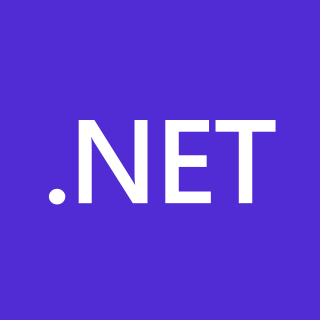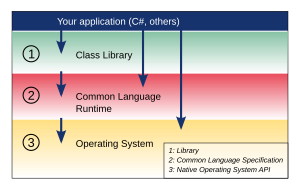The Common Language Infrastructure (CLI) is an open specification and technical standard originally developed by Microsoft and standardized by ISO/IEC and Ecma International that describes executable code and a runtime environment that allows multiple high-level languages to be used on different computer platforms without being rewritten for specific architectures. This implies it is platform agnostic. The .NET Framework, .NET and Mono are implementations of the CLI. The metadata format is also used to specify the API definitions exposed by the Windows Runtime.
Bytecode is a form of instruction set designed for efficient execution by a software interpreter. Unlike human-readable source code, bytecodes are compact numeric codes, constants, and references that encode the result of compiler parsing and performing semantic analysis of things like type, scope, and nesting depths of program objects.

GNAT is a free-software compiler for the Ada programming language which forms part of the GNU Compiler Collection (GCC). It supports all versions of the language, i.e. Ada 2012, Ada 2005, Ada 95 and Ada 83. Originally its name was an acronym that stood for GNU NYU Ada Translator, but that name no longer applies. The front-end and run-time are written in Ada.
The Shared Source Common Language Infrastructure (SSCLI), previously codenamed Rotor, is Microsoft's shared source implementation of the CLI, the core of .NET. Although the SSCLI is not suitable for commercial use due to its license, it does make it possible for programmers to examine the implementation details of many .NET libraries and to create modified CLI versions. Microsoft provides the Shared Source CLI as a reference CLI implementation suitable for educational use.
Apache Harmony is a retired open source, free Java implementation, developed by the Apache Software Foundation. It was announced in early May 2005 and on October 25, 2006, the board of directors voted to make Apache Harmony a top-level project. The Harmony project achieved 99% completeness for J2SE 5.0, and 97% for Java SE 6. The Android operating system has historically been a major user of Harmony, although since Android Nougat it increasingly relies on OpenJDK libraries.
Free/open-source software – the source availability model used by free and open-source software (FOSS) – and closed source are two approaches to the distribution of software.

C# is a general-purpose high-level programming language supporting multiple paradigms. C# encompasses static typing, strong typing, lexically scoped, imperative, declarative, functional, generic, object-oriented (class-based), and component-oriented programming disciplines.

Java is a set of computer software and specifications that provides a software platform for developing application software and deploying it in a cross-platform computing environment. Java is used in a wide variety of computing platforms from embedded devices and mobile phones to enterprise servers and supercomputers. Java applets, which are less common than standalone Java applications, were commonly run in secure, sandboxed environments to provide many features of native applications through being embedded in HTML pages.
Comparison of the Java and .NET platforms.
The Microsoft Open Specification Promise is a promise by Microsoft, published in September 2006, to not assert its patents, in certain conditions, against implementations of a certain list of specifications.

The .NET Framework is a proprietary software framework developed by Microsoft that runs primarily on Microsoft Windows. It was the predominant implementation of the Common Language Infrastructure (CLI) until being superseded by the cross-platform .NET project. It includes a large class library called Framework Class Library (FCL) and provides language interoperability across several programming languages. Programs written for .NET Framework execute in a software environment named the Common Language Runtime (CLR). The CLR is an application virtual machine that provides services such as security, memory management, and exception handling. As such, computer code written using .NET Framework is called "managed code". FCL and CLR together constitute the .NET Framework.

Mono is a free and open-source .NET Framework-compatible software framework. Originally by Ximian, it was later acquired by Novell, and is now being led by Xamarin, a subsidiary of Microsoft and the .NET Foundation. Mono can be run on many software systems.
The following outline is provided as an overview of and topical guide to C++:

The Windows Library for JavaScript is an open-source JavaScript library developed by Microsoft. It has been designed with the primary goal of easing development of Windows Store apps for Windows 8 and Windows 10, as well as Windows Phone apps for Windows Phone 8.1, Windows 10 Mobile and Xbox One applications using HTML5 and JavaScript, as an alternative to using WinRT XAML and C#, VB.NET or C++ (CX).

The Standard Libraries is a set of libraries included in the Common Language Infrastructure (CLI) in order to encapsulate many common functions, such as file reading and writing, XML document manipulation, exception handling, application globalization, network communication, threading, and reflection, which makes the programmer's job easier. It is much larger in scope than standard libraries for most other languages, including C++, and is comparable in scope and coverage to the standard libraries of Java.

The .NET platform is a free and open-source, managed computer software framework for Windows, Linux, and macOS operating systems. The project is mainly developed by Microsoft employees by way of the .NET Foundation and is released under an MIT License.
Microsoft, a technology company historically known for its opposition to the open source software paradigm, turned to embrace the approach in the 2010s. From the 1970s through 2000s under CEOs Bill Gates and Steve Ballmer, Microsoft viewed the community creation and sharing of communal code, later to be known as free and open source software, as a threat to its business, and both executives spoke negatively against it. In the 2010s, as the industry turned towards cloud, embedded, and mobile computing—technologies powered by open source advances—CEO Satya Nadella led Microsoft towards open source adoption although Microsoft's traditional Windows business continued to grow throughout this period generating revenues of 26.8 billion in the third quarter of 2018, while Microsoft's Azure cloud revenues nearly doubled.








